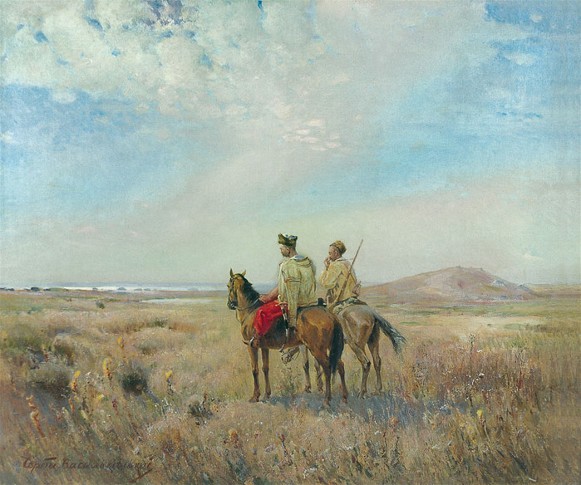Cossacks
Cossacks. The name Cossack (Ukrainian: козак; kozak) is derived from the Turkic kazak (free man), meaning anyone who could not find his appropriate place in society and went into the steppes, where he acknowledged no authority. In European sources the term first appears in a dictionary of the Cuman language in the mid-13th century. It is also found in Byzantine sources and in the instructions issued by Italian cities to their colonies on the Black Sea coast, where it is applied to armed men who were engaged in military service in frontier regions and protected trade caravans traveling the steppe routes. By the end of the 15th century the name acquired a wider sense and was applied to those Ukrainians who went into the steppes to practice various trades and engage in hunting, fishing, beekeeping, the collection of salt and saltpeter, and so on.
The history of the Ukrainian Cossacks has three distinct aspects: their struggle against the Tatars and the Turks in the steppe and on the Black Sea; their participation in the struggle of the Ukrainian people against socioeconomic and national-religious oppression by the Polish magnates; and their role in the building of an autonomous Ukrainian state. The important political role played by the Ukrainian Cossacks in the history of their nation distinguishes them from the Russian Cossacks.
First period (1550–1648). In the mid-16th century the Cossack structure in the Zaporizhia was created in the process of the steppe settlers' struggle against Tatar raids. The Tatar raids forced the army of the Grand Duchy of Lithuania to build fortresses in the southern region of Ukraine (in Kaniv, Cherkasy, Vinnytsia, Khmilnyk, Bratslav, Bar, and elsewhere). A second category of Cossacks, known as town Cossacks (horodovi kozaky), was formed for the defense of the towns. They were organized by the local officials (in Cherkasy by Ostafii Dashkevych and S. Polozovych; in Khmilnyk by Przecław Lanckoroński; in Bar by Bernard Pretwicz) as well as Samuel Zborowski, Prince Dmytro Vyshnevetsky (Baida), Prince B. Ruzhynsky, and others. These leaders, together with the town and Zaporozhian Cossacks, went far into the steppes in pursuit of the Tatars in order to rescue captives or to attack Tatar and Turkish coastal towns. In time the Cossacks acquired military strength and experience as well as prestige in their own society and fame throughout Europe, which at that time was resisting the Turkish onslaught.
Another important factor in the growth of the Ukrainian Cossacks was the socioeconomic changes taking place in the Polish-Lithuanian Commonwealth in the 16th century. Because of the favorable conditions for selling grain in Western Europe, the Polish nobility introduced the manorial system of agriculture (see Filvarok). This substantially worsened the lot of the peasantry: their land allotments were decreased, their freedom of movement was limited, and corvée was expanded. The nobility and the Polish government attempted to impose Catholicism and Polonization on the Ukrainian population. The basic form of opposition by the peasants, and to some extent by the burghers, was flight. The fugitive peasants and townspeople fled to the sparsely populated steppe, established settlements, received, for a specified period (up to 30 years), the right to a tax-exempt settlement (sloboda), and called themselves free men—Cossacks. But legal ownership of the expanses of land in the Dnipro River region was obtained from the Polish kings by the nobility, who created large latifundia and tried to impose feudal dependency on the local population—both peasants and Cossacks. By the end of the 16th and beginning of the 17th century this pressure of the magnates and nobility led to bloody conflicts in which the Cossacks fought against the Polish landowners and the Polish government: the uprisings of Kryshtof Kosynsky (1591–3), Severyn Nalyvaiko (1594–6), Hryhorii Loboda (1596), Marko Zhmailo (1625), Taras Fedorovych (1630), Ivan Sulyma (1635), Pavlo Pavliuk and Dmytro Hunia (1637), and Yakiv Ostrianyn and Karpo Skydan (1638), all of them brutally suppressed by the Poles.
The growth of Cossackdom posed a dilemma for the Polish government: on the one hand the Cossacks were necessary for the defense of the steppe frontier; on the other hand they presented a threat to the magnates and the nobles, who governed the Polish-Lithuanian Commonwealth. The government tried to regulate and control ‘the Cossack problem’ by the establishment of a register, at first small, for up to 300 persons; later, under the pressure of events, this was increased to 6,000 and then 8,000 persons. Instead of allowing elected leaders, it appointed a government ‘elder’ and colonels. But the war of the Polish Commonwealth against Muscovy, Sweden, and Turkey forced the government to make concessions to the Cossacks. In 1578 King Stephen Báthory granted them certain rights and freedoms. Gradually, the Cossacks began to conduct their own external policy independent of the government and frequently contrary to its interests (for example, they took part in Moldavian affairs and arranged a treaty with Emperor Rudolf II in the 1590s). The Cossacks became particularly strong in the first quarter of the 17th century, when Hetman Petro Konashevych-Sahaidachny not only spread their fame through his successful campaigns against the Tatars and the Turks and his aid to the Polish army at Moscow in 1618 and at the Battle of Khotyn in 1621, but also tied Cossack interests to the Ukrainian struggle against Poland, reviving the traditions of the Kyivan Rus’ state.
Second period (1648–1775). The suppression of the Cossack uprisings of the 1630s curtailed the development of the Cossack movement. The Cossack register was significantly decreased; the registered Cossacks (reiestrovi kozaky) were isolated from the ones who were excluded from the register and from the Zaporozhian Host. The offensive of the Polish Commonwealth against the Cossacks, together with intensified socioeconomic and national-religious oppression of the other classes of Ukrainian society, resulted in the Cossack-Polish War led by Hetman Bohdan Khmelnytsky and the consequent establishment of the Hetman state. Parallel to these developments, the Zaporozhian Host existed autonomously on the territory of the Zaporozhian Sich.
From 1654, when Ukraine recognized the authority of the Muscovite tsar (see Pereiaslav Treaty of 1654), the principal political problem of the Cossacks, and particularly their leaders, became the defense of the autonomous rights of Ukraine from the encroachment of Russian centralism. The hetmans Ivan Vyhovsky, Petro Doroshenko, and Ivan Mazepa tried to solve this problem by trying to separate Ukraine from Russia. After their failures later hetmans, such as Danylo Apostol, Ivan Skoropadsky and Pavlo Polubotok, although they did not advocate an open break with Russia, stubbornly defended the autonomy of Ukraine. At the same time significant socioeconomic changes were taking place among the Cossacks. In 1725 the Cossacks in Left-Bank Ukraine numbered 55,000–65,000: in addition, there were 8,000–10,000 Zaporozhian Cossacks, and 23,000 Cossacks in Slobidska Ukraine, which was part of the Russian state. Only about 50 percent of all Cossacks could afford to bear arms. In the first half of the 18th century the Cossacks and their families made up over 40 percent of the total population of Left-Bank Ukraine.
In the 18th century the socioeconomic differentiation among the Cossacks became more pronounced. Taking the privileged position of the Polish gentry as their model, the Cossack starshyna (officers) (about 1,000 families) were successful in changing their status from an elected to a hereditary one. They expropriated land from the common Cossacks and increasingly exploited the peasants. The common Cossacks were divided into two categories: the richer elect Cossacks (vyborni kozaky), who could perform military service, and the poorer Cossack helpers (pidpomichnyky), who could not afford arms or military equipment. In time a large number of Cossack helpers were reduced to the status of peasants. In 1764 the elect Cossacks and their families numbered 176,886; the Cossack helpers and their families numbered 198,295.
In Slobidska Ukraine the Cossacks enjoyed wide autonomy within the Russian state. In Right-Bank Ukraine, which until the end of the 18th century remained under Polish rule, Cossack mercenary units existed. Their center was in Dymer (Kyiv region) until the 1680s and then in Nemyriv (Bratslav region). The hetmans and colonels were appointed by the Polish government. The need to secure its border from Turkish-Tatar invasions forced the government to organize on a territorial basis. Cossack bands came from Left-Bank Ukraine and the Zaporozhian Sich and settled in the Kyiv region and Bratslav region beginning in the 1680s. With the permission of the Polish government Cossack regiments were formed in Korsun (Korsun regiment), Bratslav (Bratslav regiment), Fastiv (Fastiv regiment), and Bohuslav (Bohuslav regiment) under the command of Cossack colonels, headed by an acting hetman, Col Samiilo Samus from Bohuslav. But the actual head of the Right-Bank Cossacks was Semen Palii, colonel of Fastiv and Bila Tserkva; he led the Right-Bank Cossacks in their fight against Polish rule and oppression by the nobility and for the unification of Right-Bank Ukraine and Left-Bank Ukraine under the rule of Hetman Ivan Mazepa (the uprising of 1702). This unification was realized in 1704. This new Cossack movement in Right-Bank Ukraine lasted until 1714, when it was wiped out jointly by the Polish and Russian governments. The few remaining Cossacks were resettled in Left-Bank Ukraine. But Cossack traditions lasted in Right-Bank Ukraine throughout most of the 18th century (see Haidamaka uprisings). In 1790 the Polish Sejm decided to establish two Cossack regiments, but this resolution was never implemented.
Third period (1775–1917). The third period in the history of the Ukrainian Cossacks began with the destruction of the Zaporozhian Sich (1775) and the abolition of the Hetmanate (1780s). The abolition of the Cossack system evoked discontent among the Ukrainian populace, both from the officers, who had lost their political authority and feared they would also lose their rights as nobility (only a part of the Cossack starshyna were granted the rights of the Russian nobility), as well as from the common Cossacks, who, after the decree of 3 May 1783 on the enserfment of commoners, faced the threat of losing their privileges as an estate and even the possibility of enserfment. As a result there were numerous starshyna protests (eg, the ‘Oda na rabstvo’ [Ode on Slavery] of Vasyl Kapnist in 1782 and his mission to Berlin to receive Prussian aid in 1791) on the one hand, and a number of Cossack-peasant disturbances, which sometimes took on dimensions that threatened the existing order (eg, the Turbai uprising in 1789–93), on the other. Against this background various petitions and projects in support of the restitution of the Cossacks appeared (eg, Kapnist's project of 1788). Sometimes they were successful with the Russian authorities; for example, a Little Russian Musketeer corps in Kyiv was organized out of former Cossacks by General Andrei Levanidov in 1796, and rifleman regiments were created on the basis of former Cossack regiments and headed by former Cossack officers. Similar attempts occurred later as well, particularly when the Russian Empire was threatened (war with Turkey and France, uprisings in Poland, etc). In 1812, during the war with Napoleon Bonaparte, Senator Mykhailo P. Myklashevsky put together a project to restore Cossack regiments in Left-Bank Ukraine. This project was supported by Vasyl Kapnist and Dmytro Troshchynsky and was partially realized (with the formation of Cossack regiments, local militia, etc). It influenced the Cossack project of Prince Nikolai Repnin and I. Kapnist (the son of Vasyl Kapnist) during the Polish Insurrection of 1830–1 and later projects (eg, during the Crimean War of 1853–6).
Although these projects were only partially realized and short-lived, they nevertheless had an influence on the preservation of the Cossacks as a distinct social class in the Chernihiv region and Poltava region. The Cossack estate survived there until the Revolution of 1917 and retained its lawful rights and privileges, excluding those connected with military service. There were, however, some Cossack units, formed on the basis of the Zaporozhian Cossacks, that had a military character. These included the following: the Danubian Sich on Turkish territory (1775–1828); the Cossacks in the Banat region of the Austrian Empire (1785–1812); the Boh Cossack Army, formed in 1784, which received land between the Dnister River and the Boh River and was relocated in 1792 in the Kuban as the Black Sea Cossacks, and in 1861, after its unification with the so-called Frontier Army, was renamed the Kuban Cossack Host; and the Azov Cossack Host, formed out of parts of the Danubian host, which in 1828 went over to the Russian side, was settled on the Sea of Azov coast, and in 1865 was partially resettled in the Kuban. The Kuban Cossack Host was the only formation of Ukrainian Cossacks that still existed in 1917 and had partial and very limited autonomy.
Certain Ukrainian noble families retained their national Cossack traditions, and many of their members took part in the Ukrainian independence movement and rebirth in the 20th century. Many members of the new Ukrainian intelligentsia were descendents of the Cossacks. The influence of Cossack traditions was evident in the Ukrainian struggle for independence (1917–20), particularly in the formation of the Free Cossacks and regular army units, and in the establishment of the Hetman government in 1918. But Hetman Pavlo Skoropadsky's attempt to revive the Cossack estate was not successful.
BIBLIOGRAPHY
S[torozhenko], N. ‘K istorii malorossiiskikh kozakov v kontse XVIII i v nachale XIX veka,’ KS, 1897, nos 4, 6, 10, 11, 12
Domanyts'kyi, V. Kozachchyna na perelomi XVI–XVII st. ZNTSh, 60–64 (Lviv 1904)
Vasilenko, N. Ocherki po istorii Zapadnoi Rusi i Ukrainy (Kyiv 1916)
Okinshevych, L. Lektsiï z istoriï ukraïns'koho prava (Munich 1947)
Stökl, G. Die Entstehung des Kosakentums (Munich 1953)
Hrushevs'kyi, M. Istoriia Ukraïny-Rusy, 7–8, 2nd edn (New York 1956)
Golobutskii, V. Chernomorskoe kazachestvo (Kyiv 1956)
—, Zaporozhskoe kazachestvo (Kyiv 1957)
Diadychenko, V. Narysy suspil'no-politychnoho ustroiu Livoberezhnoï Ukraïny kintsia XVII–pochatku XVIII st. (Kyiv 1959)
Doroshenko, Dmytro. Narys istoriï Ukraïny, 2 vols (Munich 1966)
Wójcik, Zbigniew. Dzikie Pola w ogniu: O kozaczyźnie w dawnej Rzeczypospolitej, 3rd edn (Warsaw 1968)
Longworth, P. The Cossacks (New York 1969)
Serczyk, Władysław. ‘The Commonwealth and the Cossacks in the First Quarter of the Seventeenth Century,’ Harvard Ukrainian Studies, 2, no. 1 (1978)
Subtelny, Orest. The Mazepists: Ukrainian Separatism in the Early Eighteenth Century (Boulder, Colo 1981)
Gordon, L. Cossack Rebellions: Social Turmoil in the Sixteenth-Century Ukraine (Albany 1983)
Serczyk, Władysław. Na dalekiej Ukrainie: Dzieje kozaczyzny do 1648 roku (Cracow 1984)
Novyts'kyi, Ia.; Sokul's'kyi, A.; Shevchenko, V. Narodna pam’iat' pro kozatstvo/People’s Memory of Cossacks (Zaporizhia 1991)
Nalyvaiko, Dmytro. Kozats'ka khrystiians'ka respublika: Zaporiz'ka Sich u zakhidnoievropeis'kykh literaturnykh pam’iatkakh (Kyiv 1992)
Apanovych, Olena. Het'many Ukraïny i koshovi otamany Zaporiz'koï Sichi (Kyiv 1993)
Kravchenko, I.; Ivanchenko, Iu. (eds). Zaporozhtsi: Do istoriï kozats'koï kul'tury (Kyiv 1993)
Dmytrenko, O. (ed). Volodari het'mans'koï bulavy: Istorychni portrety (Kyiv 1994)
Holobuts'kyi, V. Zaporoz'ke kozatstvo (Kyiv 1994)
Smolii, Valerii et al (eds). Ukraïns'ka kozats'ka derzhava: Vytoky ta shliakhy istorychnoho rozvytku (Kyiv–Cherkasy 1994)
Dmytriienko, M. (ed). Istoriia ukraïns'koho seredn'ovichchia: Kozats'ka doba, 2 parts (Kyiv 1995)
Cadot, M.; Kruba, É.. Les Cosaques de l’Ukraine: Rôle historique, représentations littéraires et artistiques (Paris 1995)
Lep’iavko, S. Kozats'ki viiny kintsia XVI st. v Ukraïni (Chernihiv 1996)
Zashkil'niak, L. (ed). Kozats'ki viiny XVII stolittia v istorychnii svidomosti pol's'koho i ukraïns'koho narodu: Materialy Druhoï Pol's'ko-Ukraïns'koï naukovoï zustrichi (Lviv 1996)
Mytsyk, Iu. Kozats'kyi krai: Narysy z istoriï Dnipropetrovshchyny, XV–XVIII st. (Dnipropetrovsk 1997)
Shcherbak, V. Formuvannia kozats'koho stanu v Ukraïni (druha polovyna XV–seredyna XVII st.) (Kyiv 1997)
Smolii, Valerii et al (eds). Zaporoz'ke kozatstvo v ukraïns'kii istoriï, kul'turi ta natsional'nii svidomosti (Kyiv 1997)
Iakovleva, T. Het'manshchyna v druhii polovyni 50-kh rokiv XVII stolittia: Prychyny i pochatok Ruïny (Kyiv 1998)
Kryvosheia, V. Natsional'na elita Het'manstva (Personal'nyi sklad i henealohiia kozats'koï starshyny, 1648–1782) (Kyiv 1998)
Smolii, Valerii (ed). Polkovodtsi Viis'ka Zaporiz'koho: Istorychni portrety (Kyiv 1998)
Voitovych, Leontii et al (eds). Dokumenty rosiis'kykh arkhiviv z istoriï Ukraïny. Vol. 1. Dokumenty do istoriï zaporoz'koho kozatstva, 1613–1620 rr. (Lviv 1998)
Hrushevsky, Mykhailo. History of Ukraine-Rus’, vols 7, 8, 9 book 1, 9 book 2, part 1, and 9 book 2, part 2 (Edmonton–Toronto 1999–2010)
Lep’iavko, S. Ukraïns'ke kozatstvo v mizhnarodnykh vidnosynakh (1561–1591) (Chernihiv 1999)
Shcherbak, V. Ukraïns'ke kozatstvo: Formuvannia sotsial'noho stanu. Druha polovyna XV–seredyna XVII st. (Kyiv 2000)
Horobets', V. Elita kozats'koï Ukraïny v poshukakh politychnoï lehitymatsiï: Stosunky z Moskvoiu ta Varshavoiu (Kyiv 2001)
Plokhy, Serhii. The Cossacks and Religion in Early Modern Ukraine (Oxford 2001)
Kryvosheia, V. Henealohiia ukraïns'koho kozatstva: Narys istoriï kozats'kykh polkiv (Kyiv 2002)
Plokhy, Serhii. Tsars and Cossacks: A Study in Iconography (Cambridge, Mass 2002)
Turchenko, F. (ed). Ukraïns'ke kozatstvo: Mala entsyklopediia (Kyiv 2002)
Iakovleva, T. Ruïna Het'manshchyny: Vid Pereiaslavs'koï rady do Andrusovs'koï uhody (1659–1667 rr.) (Kyiv 2003)
Vynar, L. Kozats'ka Ukraïna: Vybrani pratsi (Kyiv–Lviv 2003)
Plokhy, Serhii. Nalyvaikova vira: Kozatstvo ta relihiia v ranniomodernii Ukraïni (Kyiv 2005)
Orest Subtelny, Illia Vytanovych
[This article originally appeared in the Encyclopedia of Ukraine, vol. 1 (1984).]

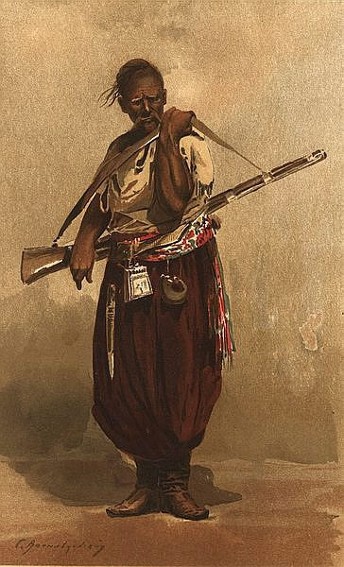
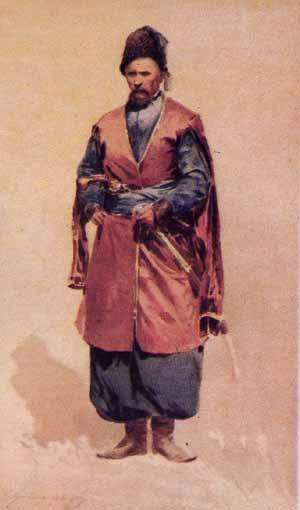
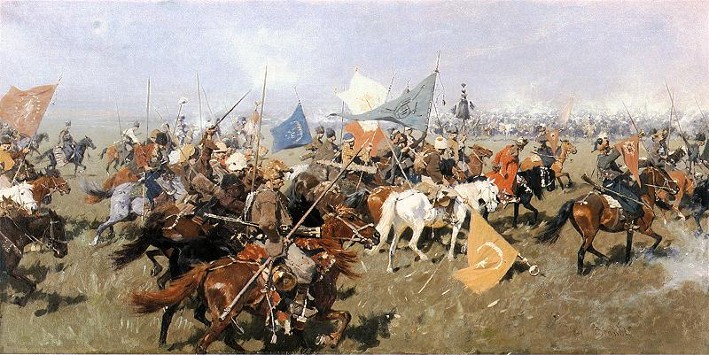
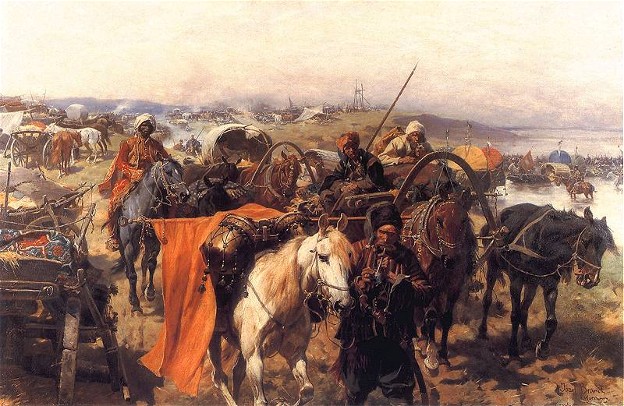
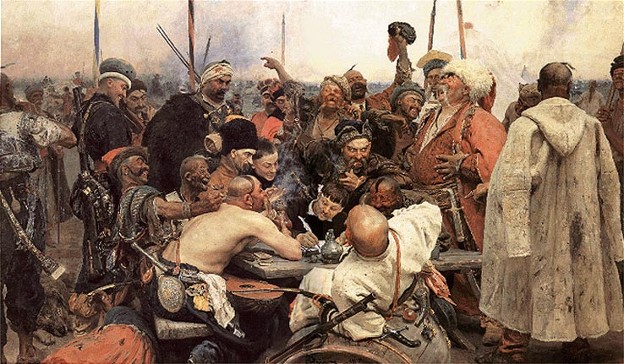
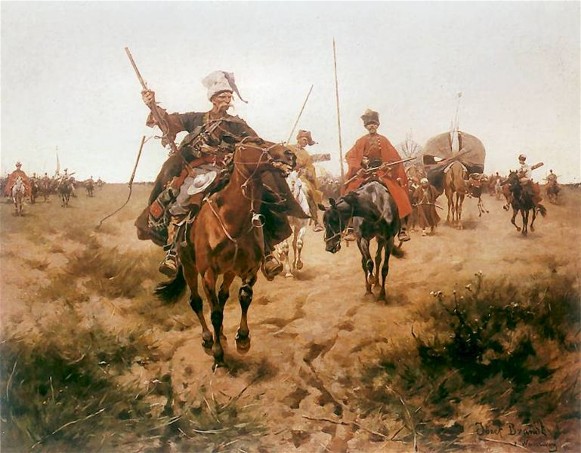
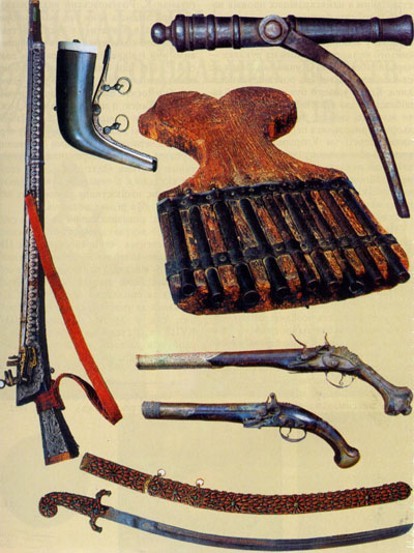
.jpg)
